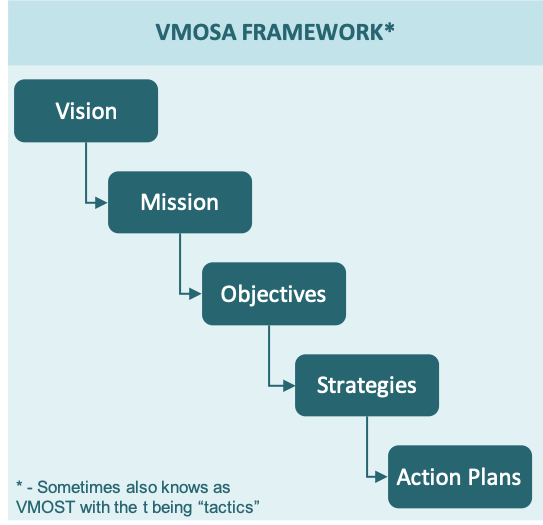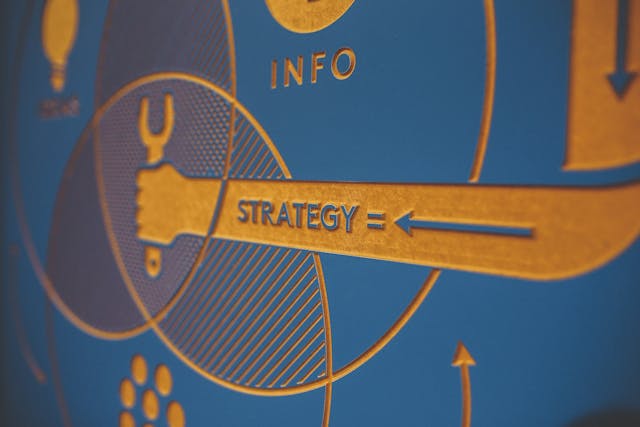The VMOSA strategic analysis framework is a simple, five step strategic process. It says organizations should start by defining a vision. They should then define a Mission, set Objectives, develop Strategies to achieve them and finally create Action plans.
Summary by The World of Work Project
The VMOSA Strategic Analysis Framework
The VMOSA Strategic Analysis Framework is a simple way to think about a strategic process that many organizations broadly follow. It provides a series of steps that fit together into a process for strategic planning. It has some overlap with The Strategic Management Framework.
Though this model is fairly simple, it provides a helpful overview of a structured way to think about organizational strategy. There are five stages to the framework which we detail below.

Stage 1: Vision
The framework follows a waterfall concept. It says that an organization’s first requirement in developing their strategy is to create a clear vision for the future. This vision can be alight to responsible business principles, or more traditional value based management.
Once organizations have agreed a vision they can move forward and be certain that the strategy they create will help them move towards where they want to be.
An example of a vision for a fictional car company could be: “A world where everyone can benefit from the power of automobiles”.
Stage 2: Mission
The second step of VMOSA is to define the organizational mission. Usually a mission builds on the vision. It defines what the organization will actually do to make its vision a reality.
An example of a mission for a fictional car company could be: “To create affordable automobiles at a global scale in an ethical way”.
Stage 3: Objectives
Once an organization has defined its vision and mission, it can move forward with the rest of its strategic planning. The third step in this framework is the creation of SMART objectives relating to the organization’s vision and mission.
These objectives ensure that the organization knows specifically what it is hoping to achieve in a given time frame. Organizations can also use them to track their progress towards achieving their vision. The insight provided by tracking objectives will help an organization re-prioritize actions and resources over time. Again, this will help ensure they progress towards achieving their vision.
An example of a single objective for a fictional car company could be: “To sell 30,000 automobiles within India over the 20XX calendar year.”
Stage 4: Strategies
The fourth step is defining specific strategies to help the organization achieve its objectives. This sounds a bit unhelpful, but it basically means that you need to define the “broad brush” or high-level approach that will be taken to ensure that each objective is likely to be met.
An example of a some strategies to support our fictional car company’s objective to sell cars in India could include: “Creating a franchise dealer network in urban India” and “Launching a community sharing and finance scheme in rural India”.
Stage 5: Action Plans (Tactics)
The last step of The VMOSA Strategic Analysis Framework process is the creation of action plans (AKA Tactics). These action plan detail how the organization will make each strategy happen. Organizations should create fairly detailed action plans that include timelines for achievement. In many organizations program or project management teams may own these action plans.
An example of an action plan for our fictional car company’s strategy to create a franchise dealer network in urban India could include: “Hire strategic leader, structure franchisee legal terms and market opportunity”, or similar.

Learning More
We’ve written a handful of articles on strategic topics in. These include one on Porter’s Five Forces, one on the Strategic Management Framework and one on Agile Working. We also think that deciding whether or not to become a responsible business is an important strategic decision
You might enjoy our podcast on Vision and Mission statements too:
The World of Work Project View
The VMOSA Strategic Analysis Framework has some flaws, but isn’t too bad of a way to start thinking about how to design then achieve a strategy within your organization. You can also use it to create a personal strategy for your self.
Once tactics have been identified, organizations need to go through a cost benefit prioritization approach to decide which to implement. To really be effective, strategy needs to include more analysis than is shown in this model. This analysis needs to consider both internal and external factors and expectations for the future.
In addition, models like this should be used at an organizational or system level to create the most value. If they’re done at sub-levels, then silos may pursue their own goals, not organization goals.
Overall it’s a useful tool, but more as general guidance around some of the through processes of strategy than anything else.
How We Help Organizations
We provide leadership development programmes and consulting services to clients around the world to help them become high performing organizations that are great places to work. We receive great feedback, build meaningful and lasting relationships and provide reduced cost services where price is a barrier.
Learning more about who we are and what we do it easy: To hear from us, please join our mailing list. To ask about how we can help you or your organization, please contact us. To explore topics we care about, listen to our podcast. To attend a free seminar, please check out our eventbrite page.
We’re also considering creating a community for people interested in improving the world of work. If you’d like to be part of it, please contact us.
Sources and Feedback
This post is not based on any specific books. We have written it based on a mix of work related experience and sources from around the internet. University of Kansas have written an interesting summary of the framework as part of their Community Tool Box. It focuses on the creation of a public health intervention. You can read more here.
We’re a small organization who know we make mistakes and want to improve them. Please contact us with any feedback you have on this post. We’ll usually reply within 72 hours.






